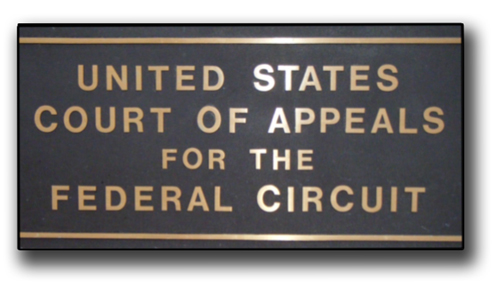by Ryan H. Flax, Esq.
(Former) Managing Director, Litigation Consulting
A2L Consulting
In patent law, usually the U.S. Court of Appeals for the Federal Circuit (affectionately called the Federal Circuit or just Fed. Cir. for short by us patent practitioners) has the last say in any case. It’s the court of appeal for patent cases in the U.S. and has made most of the law on patent infringement and validity. As a patent attorney, I’ve had my cases heard before the Fed. Cir. and as a litigation consultant, I’ve worked with retired Fed. Cir. judges in helping prepare appeal teams for their oral argument before the court. After just doing so in collaboration with a (very impressive) retired Fed. Cir. judge, I’ve identified 11 things you must consider when getting ready for your own oral argument. Read on below and, once you have, I invite your feedback, either by email or as a comment below.
 1. Practice, practice, practice.
1. Practice, practice, practice.
It may seem obvious, but you need to practice your oral argument - like crazy. It needs to become like reciting the pledge of allegiance. You must be able to recite your 15-minute argument all the way through and do so convincingly. You also need to be able to begin the argument, get interrupted, discuss something tangential to your argument, and then jump right back in where you left off and do it in a way that makes sense and flows well.
You will have a total of 15 minutes to make your case at oral argument, but you’ll never be able to do it from beginning to end in the real hearing because the judges will likely interrupt you just moments after you say “May it please the court,” to ask the questions they’ve been wanting to ask since they read your brief. But, that doesn’t mean you shouldn’t be prepared to do so. And, being prepared in this way will allow you to stay on your own agenda, rather than bending completely to the direction the Fed. Cir. panel forces you to take with their questions.
I just listened to the oral argument of a client at the Fed. Circuit. We’d prepared for every conceivable question the panel could offer, and our client was ready. However, the panel was surprisingly laid back compared to most. They did ask a few questions, but, for the most part, had little to say. This was an opportunity for counsel to really argue and present all the reasons why his client should win. But, to do that, you need to be ready to do it and have your arguments in the bag.
2. Craft a sharp, focused, and memorable introduction.
As I just mentioned, it’s likely that you will have barely gotten through your introduction to the Court when you’ll be interrupted by the panel asking a question. For this reason, it’s of paramount importance that you have a terse, memorable, and eloquent statement for why you should win that you can lead with.
 Everyone reading this article knows the quote to the right and who made it. Johnnie Cochran was certainly not arguing before the Fed. Cir. when he said those famous words, but they were supremely effective in setting O.J. Simpson free. This one line summed up the entirety of the defense’s position on the case – “the evidence just doesn’t fit here, something’s wrong, and you can’t convict O.J.” I’m not suggesting you begin your Fed. Cir. argument with a rhyme or something silly, but whatever you say should stick with the judges after the hearing is over and it should encapsulate your case for them, because it’s not impossible that this could be the only scripted part of what you actually argue at the podium.
Everyone reading this article knows the quote to the right and who made it. Johnnie Cochran was certainly not arguing before the Fed. Cir. when he said those famous words, but they were supremely effective in setting O.J. Simpson free. This one line summed up the entirety of the defense’s position on the case – “the evidence just doesn’t fit here, something’s wrong, and you can’t convict O.J.” I’m not suggesting you begin your Fed. Cir. argument with a rhyme or something silly, but whatever you say should stick with the judges after the hearing is over and it should encapsulate your case for them, because it’s not impossible that this could be the only scripted part of what you actually argue at the podium.
3. Give the panel a good reason to listen to you.
Most Federal Circuit cases are won and lost on the briefs and, so, the oral argument may be of less importance both generally and to the Court. However, I’m sure you’re not willing to forgo your chance to explain why you should win in the courtroom. If you want your oral argument to have the impact it should, you need to have the judges listen to what you have to say, not just use you as a punching bag for their questions.
To do this you must have an introduction that explains to the panel that what they’re about to hear, they could not get by simply reading the briefs. You need to explain why what you’re about to say is different, more focused, and, perhaps, will clarify things that may have seemed confusing from simply reading the papers.
You want to get the panel sitting back in their seats, both figuratively and literally, so they are waiting to hear what you’ll say and so they will hear you out. If you don’t do this, you’re on the Court’s agenda, not your own.
 4. Focus on the paper.
4. Focus on the paper.
All that matters to the court is the record. Appeal courts in general are slaves to the record. If something didn’t happen on paper, it didn’t happen at all as far as the Fed. Cir. is concerned.
So, how do you include this knowledge in your oral argument strategy? The answer is that you need to have a solid cite to the appeal record for each and every point you want to make and for each and every response to every conceivable question the Court may ask.
You also need to be able to find the things you identify as supportive in the record so you can quote from the record. Have a copy, tabbed and ready with you at the podium. Have your second chair as familiar with your argument and tabbed record as you are and have his own so that he or she can help you should you become “flustered” at the podium.
5. Use a demonstrative or two.
Using demonstrates during Fed. Cir. oral argument is not common, but that doesn’t mean you shouldn’t consider it. If a graphic might help you make your argument or help you explain something complicated about the patent and/or technology at issue, have such a litigation graphic professionally created in consultation with a litigation consultant. But, you need to carefully consider doing this.
First, if you get to use a demonstrative at oral argument at all, you’ll likely only get to use one. So, you’d better make that one graphic count. It should be useful for several purposes. For example, using an image or illustration of the accused infringing device can be useful both to explain your own invention and the proper claim constructions and also how the accused thing infringed the correctly construed claims.
Second, be careful. A lot can go wrong using a demonstrative in the Fed. Cir. It’s not as dangerous as an animal act on live late night TV, but you can certainly look pretty un-smooth if you’re not well versed in what the demonstrative shows, how you plan on using it, or if you haven’t practiced actually referencing the board while you argue. And, that’s precisely the type of demonstrative I suggest, a very large, clear, and precise poster-board graphic. And, another real danger is that you will “fall in love” with your demonstrative so much that you overuse it as a tool. Be careful not to become a slave to your graphic, don’t turn your back on the panel while using it, and stop using it when its usefulness has ended.
 6. You have to manage your time, the court won’t do it for you.
6. You have to manage your time, the court won’t do it for you.
Each party gets 15 minutes to argue before the Court – use and manage your time wisely. The Court will do nothing but monopolize your time – it will not manage your time or urge you along your argument agenda.
If you are the appellant you’re going to argue first, but you also want to argue last so be sure to tell the court you want to reserve between 3 and 5 minutes for a rebuttal after the respondent argues. When you get down to the 10 or 12 minute mark, you need to put the brakes on and remind the panel that you intended to reserve time for rebuttal because if you let the Court go on, it will and it may steal away your rebuttal if you don’t speak up.
When you’re arguing there are lights at the podium. When the lights turn yellow, your time is running out and when they’re red, you’re out of time. When you’re out of time, that’s it unless the Court makes an exception for you. Sometimes this happens if the panel asks an excessive number of questions and recognizes that it’s pushed you over the time limit. Usually if this happens, the panel will grant you the extra time and also add an equal amount to the opposing side’s argument.
Part of managing your time is being prepared to respond in a completely responsive, but pithy way to every question the panel might ask. Doing so allows you to be respectful of the Court, but also get back to your own points.
Considering your introduction, the time taken up by the judges asking questions, and, if you’re the appellant, your rebuttal time, you’ve really only got about 6-8 minutes of oral argument, so make the best of it. And, you’re likely going to be a bit flustered, so practice and be prepared to handle this time management.
7. Seek help.
Get feedback from outsiders, like me, on how your planned argument is going to go over at the Fed. Cir. Sure, you’re a very smart person and an experienced and talented attorney, but that doesn’t necessarily or automatically mean you’re going to make a great presentation to the Court. Part of getting to the appeal is likely drinking a lot of your own Kool-Aid. You’ve had to convince yourself that your case is a winner, had to try to convince opposing counsel your case is a winner, and try to convince the district court judge and the jury that your case is a winner. Then you had to write a super-compelling and persuasive 14,000-word brief. After all this, it’s understandably hard to view your position and arguments objectively.
That’s where I come in. You can have the partner down the hall sit with you and listen to your ideas about oral argument and even watch you practice, but it’s unlikely you’re going to get the type of objective feedback you need under such circumstances. I recommend conducting a mock oral argument before a mock panel. You need to prepare carefully and thoroughly for such a mock exercise and you need to be grilled with the toughest questions anyone associated with the case, including me, can think of. If you do not practice in this way, unless you do Fed. Cir. oral arguments frequently, you’re not going to be ready when the day comes (at least not in my book of “ready”).
 8. Prepare to be the most reasonable person in the room.
8. Prepare to be the most reasonable person in the room.
You need to be well-reasoned in all aspects of your oral argument. Any point you’re affirmatively making must be backed up, and backed up well, by some point in the record and you need to be able to direct the court right to that record-cite. When responding to the panel’s questions, you need to have anticipated the issue and have a terse, one sentence, reasonable answer to that question that fits with your appeal positions (and you need a record cite to back it up, too).
If you have an argument that’s a loser, concede it unless it’s dispositive and focus on what you need to to win the war. Maybe you’ve brought some superfluous causes of action that can be dropped while maintaining your case-at-large. Maybe some of your patent’s claims can be allowed to be either abandoned (in terms of infringement) or acknowledged to be (possibly) invalid if it saves the patent and case, generally.
Basically, don’t fight needless and likely-losing battles just to sacrifice the war. Look like a reasonable person. It’s easier to take your case and points seriously if you are.
9. Be ready for anything and everything.
Brainstorm and identify every single possible question that may be asked and have a one sentence, perfect answer for each. Over-do this preparation.
You really do need to spend a lot of time imagining what questions may be asked by the panel because, for all the reasons discussed above, you need to be ready for what the judges will throw at you. You need to have an understandable, reasonable, and completely responsive answer for anything and everything a judge might question – and that answer must fit within the confines of a single sentence or two, at most.
All the judges have to go on is the briefing in the case, the record, and whatever their clerks have to report before the hearing. Re-read all this stuff again. Have an outsider read it and give you feedback. Ask yourself: where are the holes in my argument? What points seem strongest for the opposition based on their brief? What might be confusing based on the briefs alone?
Ask: What can the judges do to simply dispose of this case without much fuss. This last one identifies what the judges’ primary goal will be during the hearing. If they can identify a simple reason to rule one way or another and develop a reasonable rationale for that reason, that’s the path of least resistance and the one most likely to be taken. Be ready.
10. On rebuttal, don’t rehash.
Rebuttal is available to rebut, not to review and restate arguments already made. As confirmed by my retired-judge-collaborator, the Fed. Cir. judges will just tune you out (at best) if you rehash and could affirmatively end your argument for you (at worst).
Listen carefully to what your opposition argues and to the questions asked by the panel during your opposition’s argument. If opposing counsel makes a good point – counter it on rebuttal. If the judges seem to identify a chink in your opposition’s armor – drive your sword into it and make it bigger (tell the panel how astute they were to see it and how important it is to why you should win).
Take your time during the opposition’s oral argument to read any notes your second chair may provide you – they were likely dying for you to say something specific during your argument that you just didn’t think of in the stress of the situation – you can make that point on rebuttal. Carefully consider how your argument went and the questions asked by the judges. What did you do well and where could you have done better? What could you fix by rephrasing or by identifying an appropriate cite to the record? Do it when you get the chance.
Of course, all this rebuttal strategy only works if you’re the appellant because the respondent (appellee) does not get a rebuttal.
 11. Write a brief that the Court can follow, easily.
11. Write a brief that the Court can follow, easily.
Lastly here, but the first thing you should do in a real appeal, make sure your brief is a winner, not just on the facts and law, but in how it’s formatted and organized. I leave it to you to know what issues must be addressed and what precedent supports your positions, but I believe you need to make your brief a “recipe” for victory.
As discussed above, most cases are won on the briefs. You don’t want to have to rely on giving a perfect oral argument, because it’s likely too late by then. Set your brief up in a way that the Court can instantly recognize your primary points. I suggest setting it up in a “check-list” style.
What this means is that a reader (the Court) should be able to fully understand the entirety of your argument and why you should “win” by simply reading the headings of your brief. The headings should be terse, but crystal clear in their point. The rest of the brief (the substance under the headings) should be there simply for the purpose of supporting the big points you’ve made in the headings. This way, when the judges initially read your brief, it’s simple to follow along and there’s a clear organization to your arguments. Then, when the judges want to review your brief right before your oral argument (which they likely will), they can get through it quickly and understand it – checking off your arguments and rationale.
When I say make your brief a “recipe” for victory, I mean that it should be as easy to follow and as understandable as a cookbook. You should give the Court exactly what it needs (the steps and ingredients under the appropriate burden) to rule in your favor, but not so much embellishment that it detracts from the clarity of your positions.
I hope you’ve found the 11 suggestions above informative and thought provoking. I believe if you follow my advice, you will be ahead of the game for your next oral argument before the Fed. Cir. (or, really, any appeal court).
Some other A2L Consulting materials related to arguing cases in the Federal Circuit, in patent litigation or at trial generally are linked below:
- FREE DOWNLOAD: The Patent Litigation Trial Presentation Toolkit
- 3 Ways to Force Yourself to Practice
- Preparing for ITC Hearings
- VIDEO: Trial Graphics in Patent Litigation - 11 Tips for Success
- Mock Markman Hearings
- Look like a movie lawyer by practicing like one








Leave a Comment